Advanced Wind Speed Prediction Model Based on a Combination of Weibull Distribution and an Artificial Neural Network
Abstract
:1. Introduction
2. Related Work
2.1. Weibull Distribution
2.2. Description of the ANN Model
3. Proposed Model
3.1. Description of the ANN Prediction Model
3.2. Description of the Weibull Distribution Model
- Set the Weibull distribution parameters’ shape and scale.
- Generate a uniformly distributed random number U between [0, 1].
- Generate the random variable with the inverse transform of the modified cumulative Weibull distribution function as in Equation (3).
- Generate the artificial wind speed v with Equation (6).
3.3. Procedures for the Integrated Model
- Firstly, the fitting of the Weibull parameters to randomly create the hourly wind speed.
- Secondly, applying the ANN to intensify the hourly wind speed data to match the characteristics of the actual wind speed data.
- Thirdly, the period of prediction is based on the required period of time generated.
3.4. Analysis of the Prediction Error
4. Wind Data Characteristics at Selected Locations in Malaysia
5. Results and Discussion
5.1. Weibull Parameter Results
5.2. Weibull Model for the Prediction and Simulation of Wind Speed
5.3. Implementation of the ANN Model and HANN Model for Validation of the Results
6. Conclusions
Acknowledgments
Author Contributions
Conflicts of Interest
References
- Shuai, S.; Lo, K.L. An Overview of Wind Energy Development and Associated Power System Reliability Evaluation Methods. In Proceedings of the 48th International Universities Power Engineering Conference (UPEC), Dublin, Ireland, 2–5 September 2013; pp. 1–6. [Google Scholar]
- Global Wind Energy Council. Global Wind Statistics 2015. Available online: http://www.gwec.net/ (accessed on 10 February 2016).
- Anurag, C.; Saini, R.P. Statistical Analysis of Wind Speed Data Using Weibull Distribution Parameters Statistical Analysis of Wind Speed Data Using. In Proceedings of the 1st International Conference on Non-Conventional Energy (ICONCE2014), Kalyani, India, 16–17 January 2014. [Google Scholar]
- Kidmo, D.K.; Danwe, R.; Doka, S.Y.; Djongyang, N. Statistical analysis of wind speed distribution based on six Weibull Methods for wind power evaluation in Garoua, Cameroon. Revue Des Energies Renouvelables 2015, 18, 105–125. [Google Scholar]
- Liu, H.; Chen, C.; Tian, H.; Li, Y. A hybrid model for wind speed prediction using empirical mode decomposition and artificial neural networks. Renew. Energy 2012, 48, 545–556. [Google Scholar] [CrossRef]
- Peng, H.; Liu, F.; Yang, X. A hybrid strategy of short term wind power prediction. Renew. Energy 2013, 50, 590–595. [Google Scholar] [CrossRef]
- Liu, H.; Tian, H.; Li, Y. Comparison of two new ARIMA-ANN and ARIMA-Kalman hybrid methods for wind speed prediction. Appl. Energy 2012, 98, 415–424. [Google Scholar] [CrossRef]
- Cadenas, E.; Rivera, W.; Campos-amezcua, R.; Heard, C. Wind speed prediction using a univariate Arima model and a multivariate NARX Model. Energies 2016, 9, 109. [Google Scholar] [CrossRef]
- Okumus, I.; Dinler, A. Current status of wind energy forecasting and a hybrid method for hourly predictions. Energy Convers. Manag. 2016, 123, 362–371. [Google Scholar] [CrossRef]
- Li, G.; Shi, J.; Zhou, J. Bayesian adaptive combination of short-term wind speed forecasts from neural network models. Renew. Energy 2011, 36, 352–359. [Google Scholar] [CrossRef]
- Li, G.; Shi, J. On comparing three artificial neural networks for wind speed forecasting. Appl. Energy 2010, 87, 2313–2320. [Google Scholar] [CrossRef]
- Fortuna, L.; Nunnari, G.; Nunnari, S. A new fine-grained classification strategy for solar daily radiation patterns. Pattern Recognit. Lett. 2016, 81, 110–117. [Google Scholar] [CrossRef]
- Chen, F.; Li, F.; Wei, Z.; Sun, G.; Li, J. Reliability models of wind farms considering wind speed correlation and WTG outage. Electr. Power Syst. Res. 2014, 119, 385–392. [Google Scholar] [CrossRef]
- Alexandre, P.; Rocha, C.; De Sousa, R.C.; De Andrade, C.F.; Eugênia, M. Comparison of seven numerical methods for determining Weibull parameters for wind energy generation in the northeast region of Brazil. Appl. Energy 2012, 89, 395–400. [Google Scholar]
- Kadhem, A.A.; Wahab, N.I.A.; Bin Aris, I.; Jasni, J.; Abdalla, A.N. Effect of wind energy unit availability on power system adequacy. Indian J. Sci. Technol. 2016, 9, 1–7. [Google Scholar] [CrossRef]
- Kadhem, A.A.; Wahab, N.I.A.; Aris, I.; Jasni, J.; Abdalla, A.N.; Matsukawa, Y. Reliability assessment of generating systems with wind power penetration via BPSO. J. Int. J. Adv. Sci. Eng. Inf. Technol. 2017, 7, 1248–1254. [Google Scholar] [CrossRef]
- Hocaoglu, F.O.; Gerek, O.N.; Kurban, M. A novel wind speed modeling approach using atmospheric pressure observations and hidden Markov models. J. Wind Eng. Ind. Aerodyn. 2010, 98, 472–481. [Google Scholar] [CrossRef]
- Kadhem, A.A.; Izzri, N.; Wahab, A.; Aris, I.; Jasni, J.; Abdalla, A.N. Reliability assessment of power generation systems using intelligent search based on disparity theory. Energies 2017, 10, 343. [Google Scholar] [CrossRef]
- Moharil, R.M.; Kulkarni, P.S. Generator system reliability analysis including wind generators using hourly mean wind speed. Electr. Power Compon. Syst. 2007, 36, 1–16. [Google Scholar] [CrossRef]
- Yeh, T.; Wang, L. A study on generator capacity for wind turbines under various tower heights and rated wind speeds using weibull distribution. IEEE Trans. Energy Convers. 2008, 23, 592–602. [Google Scholar]
- Negnevitsky, M. Artificial Intelligence: A Guide to Intelligent Systems, 3rd ed.; Pearson Education Limited: Essex, UK, 2011. [Google Scholar]
- Jung, J.; Broadwater, R.P. Current status and future advances for wind speed and power forecasting. Renew. Sustain. Energy Rev. 2014, 31, 762–777. [Google Scholar] [CrossRef]
- Ramasamy, P.; Chandel, S.S.; Yadav, A.K. Wind speed prediction in the mountainous region of India using an artificial neural network model. Renew. Energy 2015, 80, 338–347. [Google Scholar] [CrossRef]
- Safari, B.; Gasore, J. A statistical investigation of wind characteristics and wind energy potential based on the Weibull and Rayleigh models in Rwanda. Renew. Energy 2010, 35, 2874–2880. [Google Scholar] [CrossRef]
- Kaoga, D.K.; Serge, D.Y.; Raidandi, D.; Djongyang, N. Performance assessment of two-parameter weibull distribution methods for wind energy applications in the district of maroua in cameroon. Int. J. Sci. Basic Appl. Res. (IJSBAR) 2014, 17, 39–59. [Google Scholar]
- Doucoure, B.; Agbossou, K.; Cardenas, A. Time series prediction using artificial wavelet neural network and multi-resolution analysis: Application to wind speed data. Renew. Energy 2016, 92, 202–211. [Google Scholar] [CrossRef]
- Khatib, T.; Mohamed, A.; Sopian, K. Modeling of Wind Speed and Relative Humidity for Malaysia Using ANNs: Approach to Estimate Dust Deposition on PV Systems. In Proceedings of the 5th International power Engineering and Optimization Conference (PEOCO2011), Shah Alam, Selangor, Malaysia, 6–7 June 2011; pp. 42–47. [Google Scholar]
- Masseran, N.; Razali, A.M.; Ibrahim, K.; Zin, W.Z.W. Evaluating the wind speed persistence for several wind stations in Peninsular Malaysia. Energy 2012, 37, 649–656. [Google Scholar] [CrossRef]
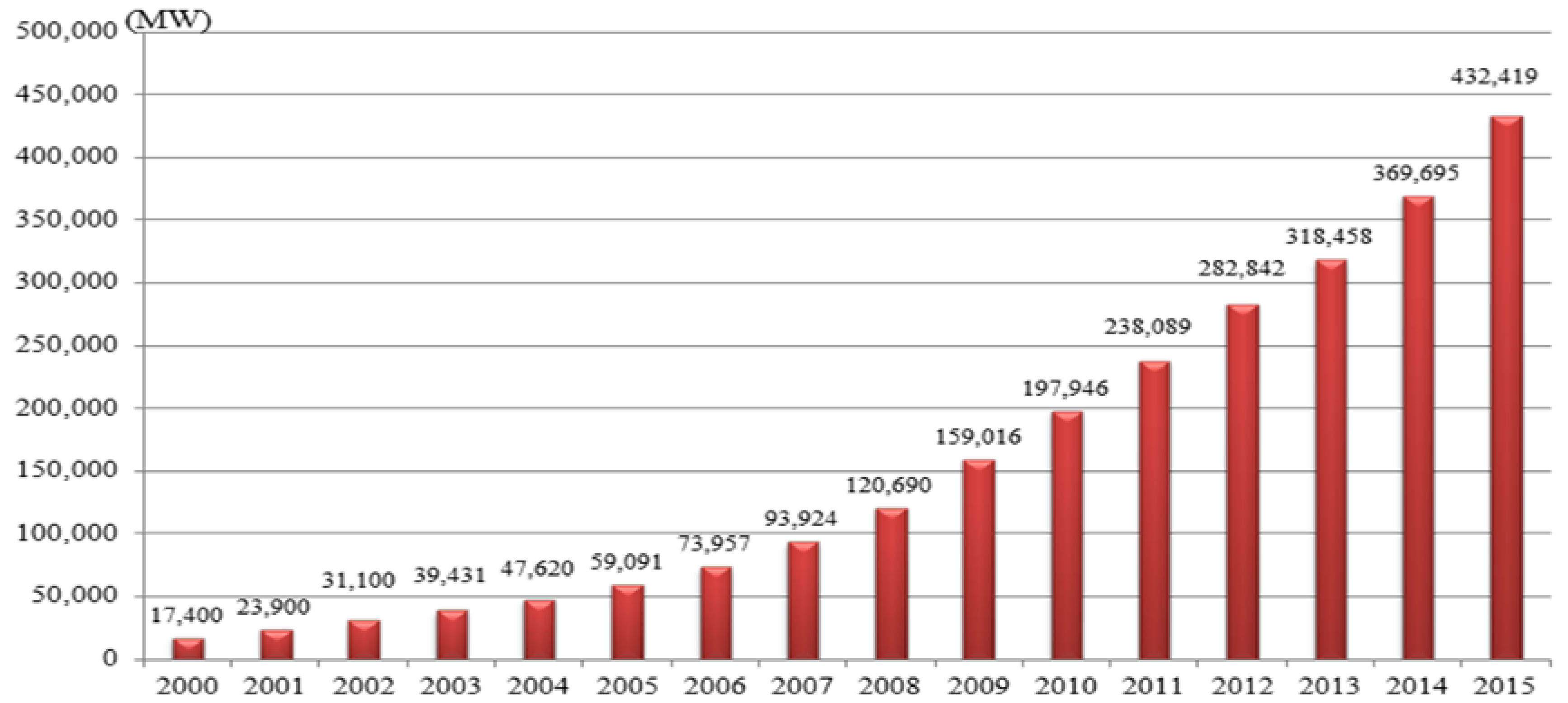
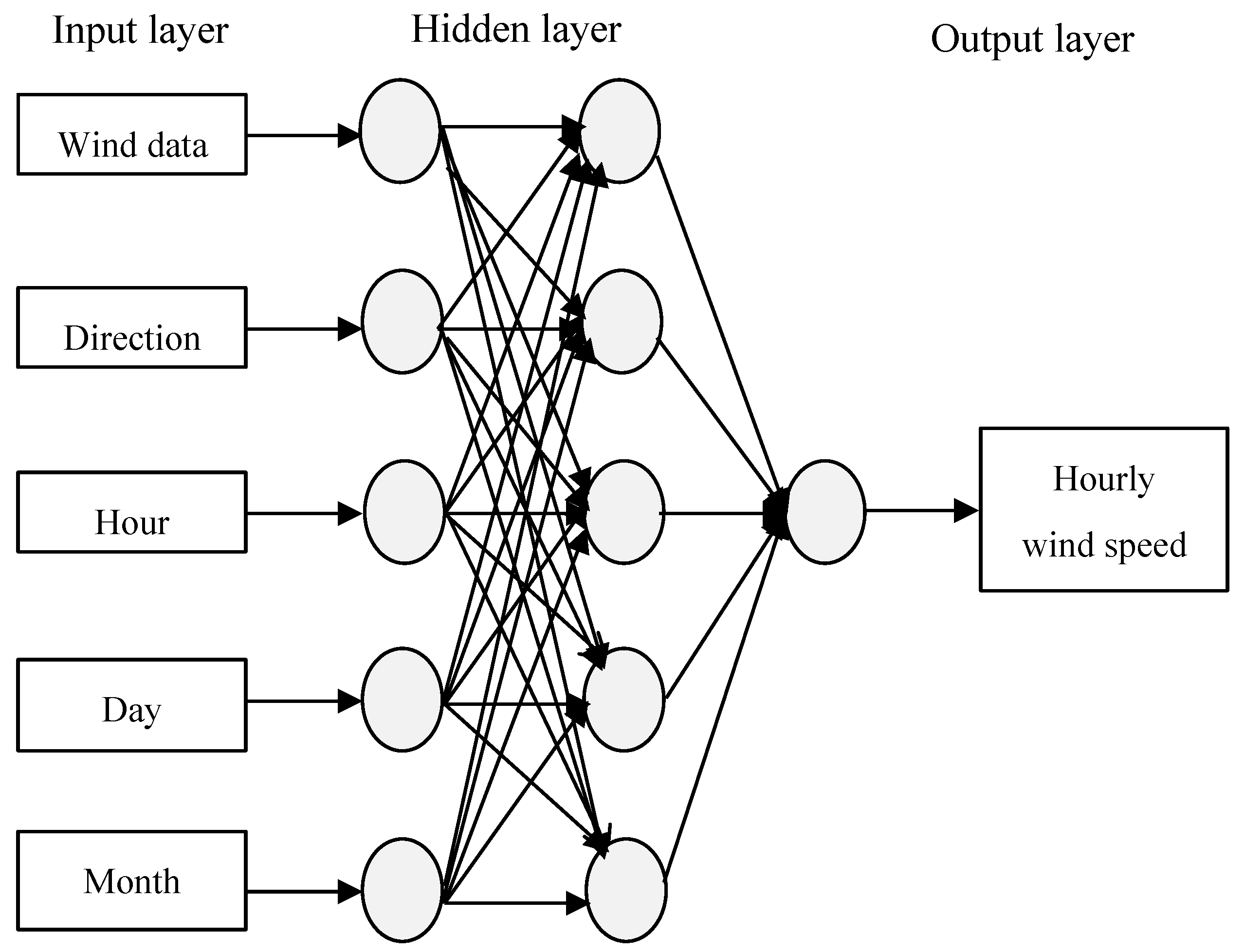

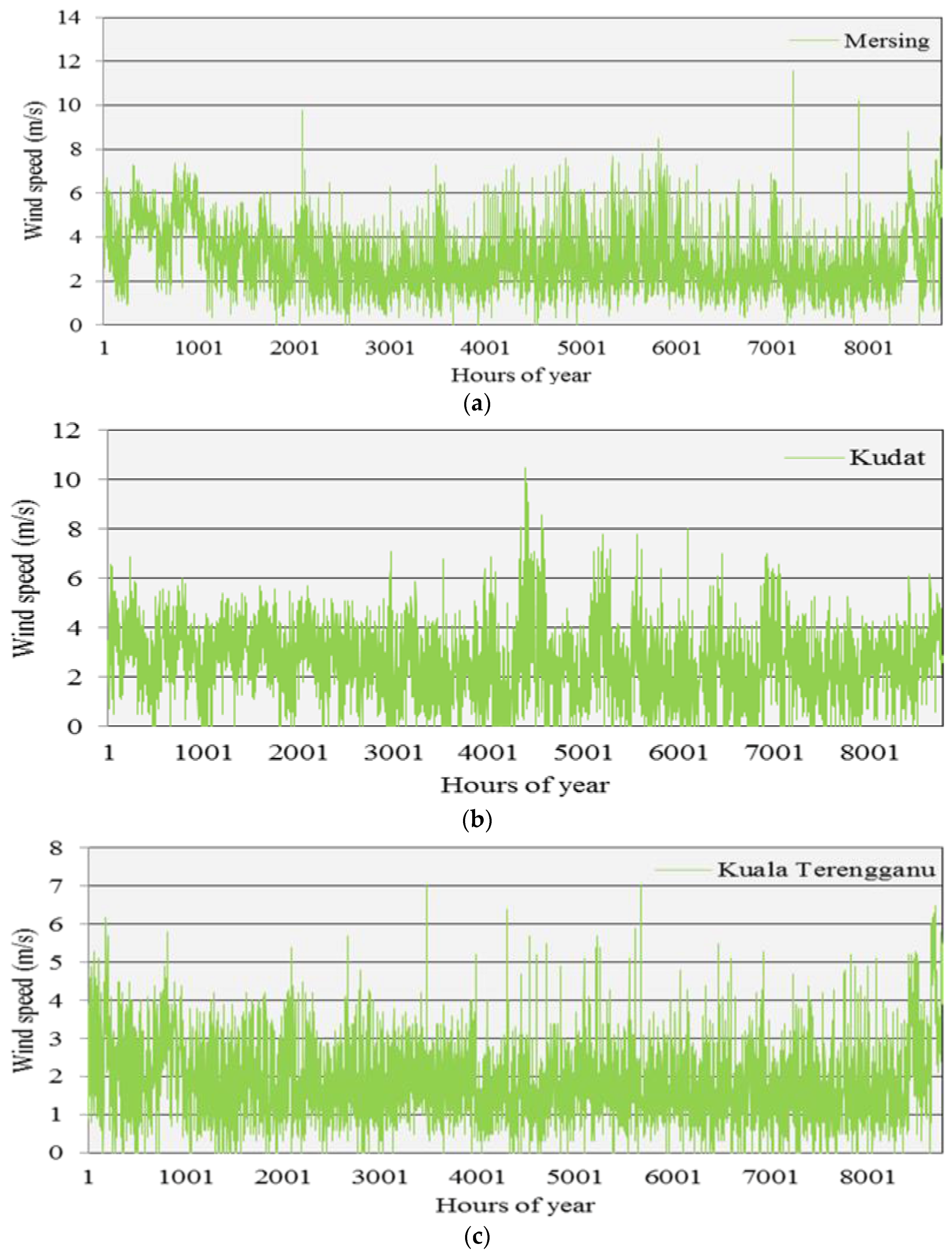
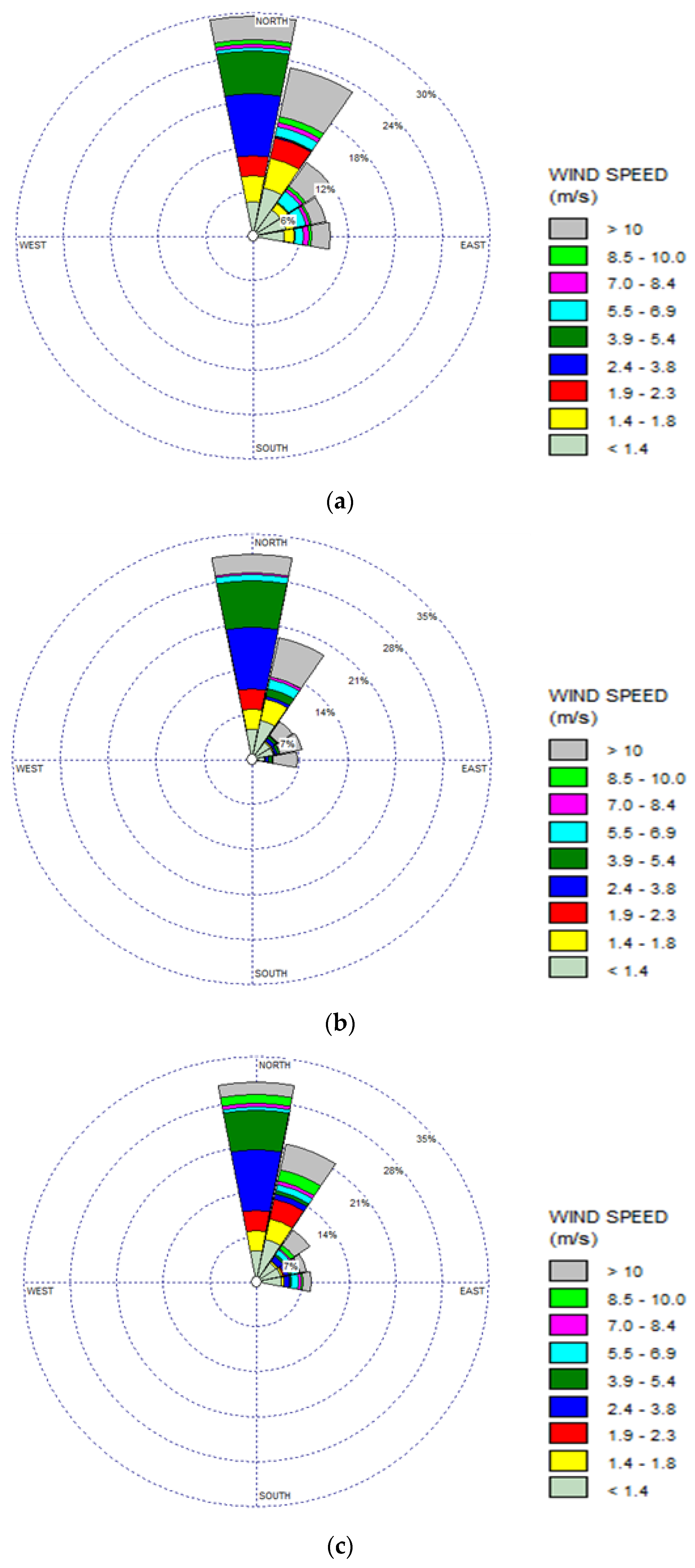
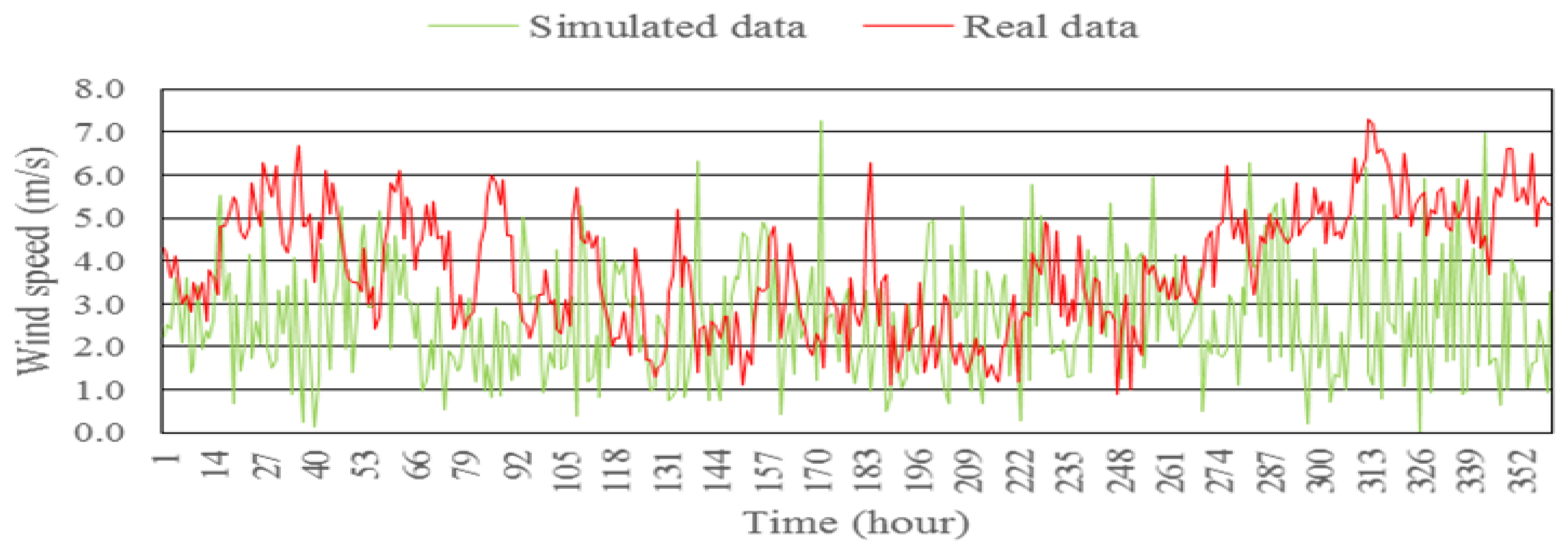
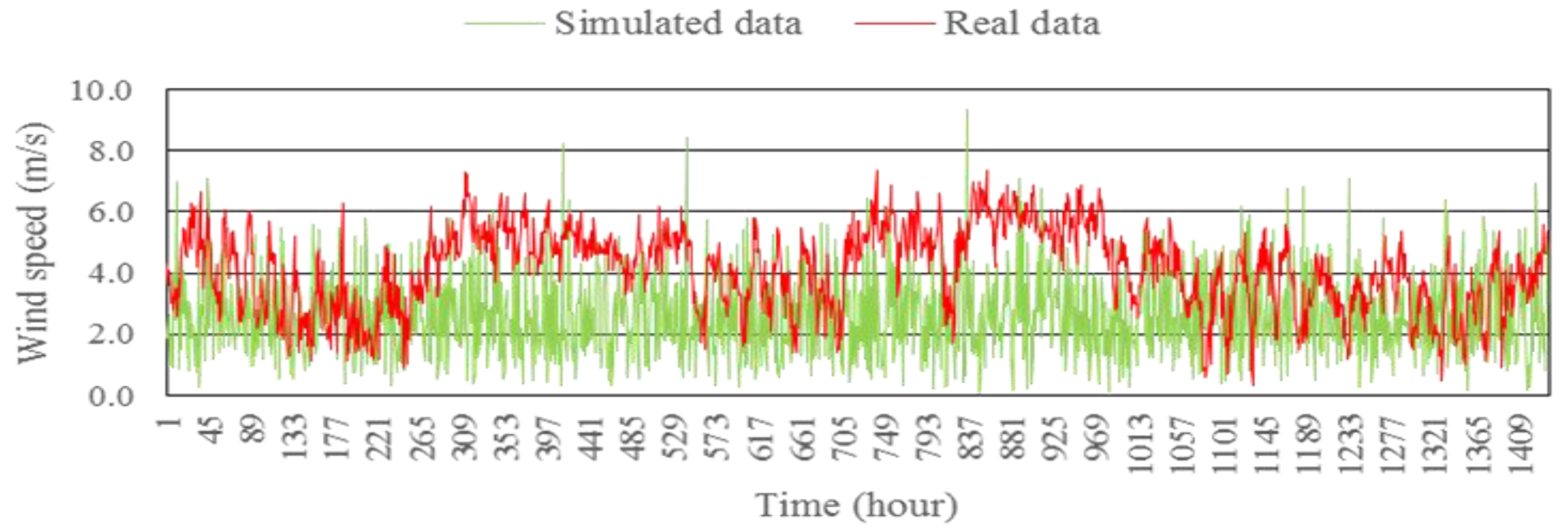
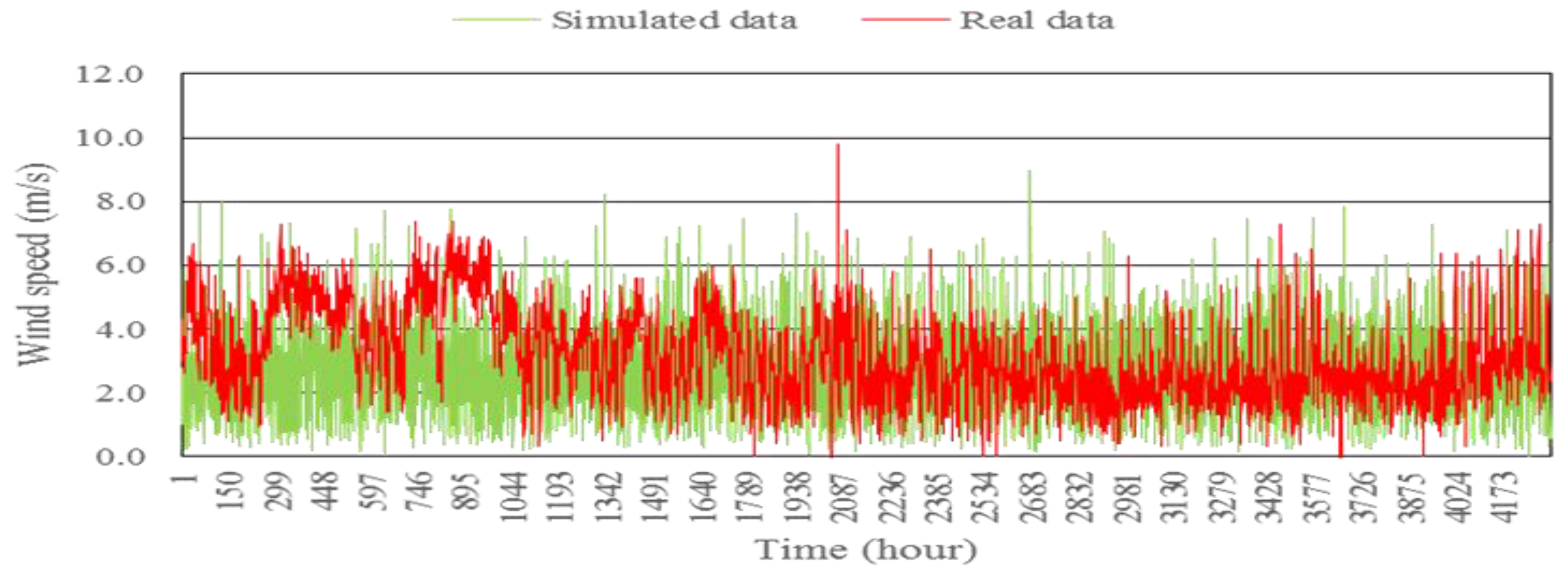
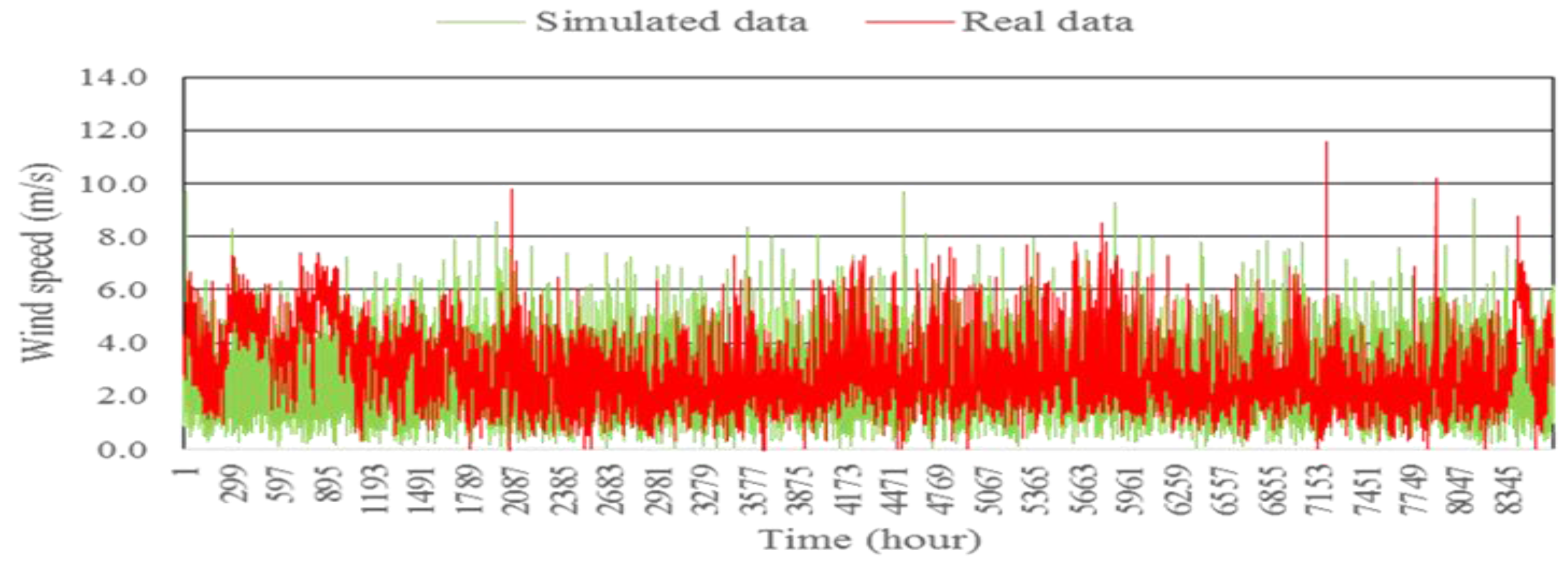
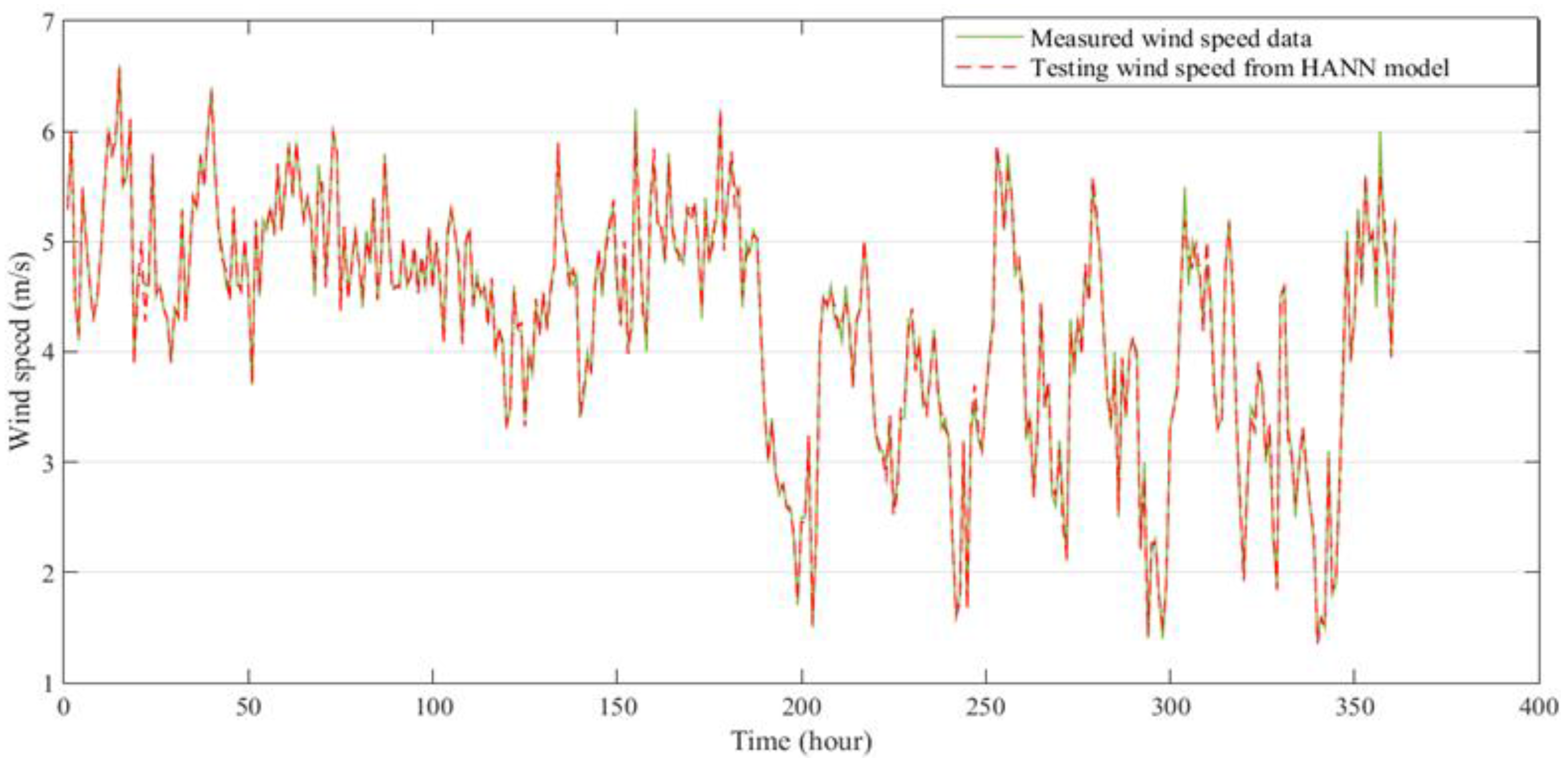

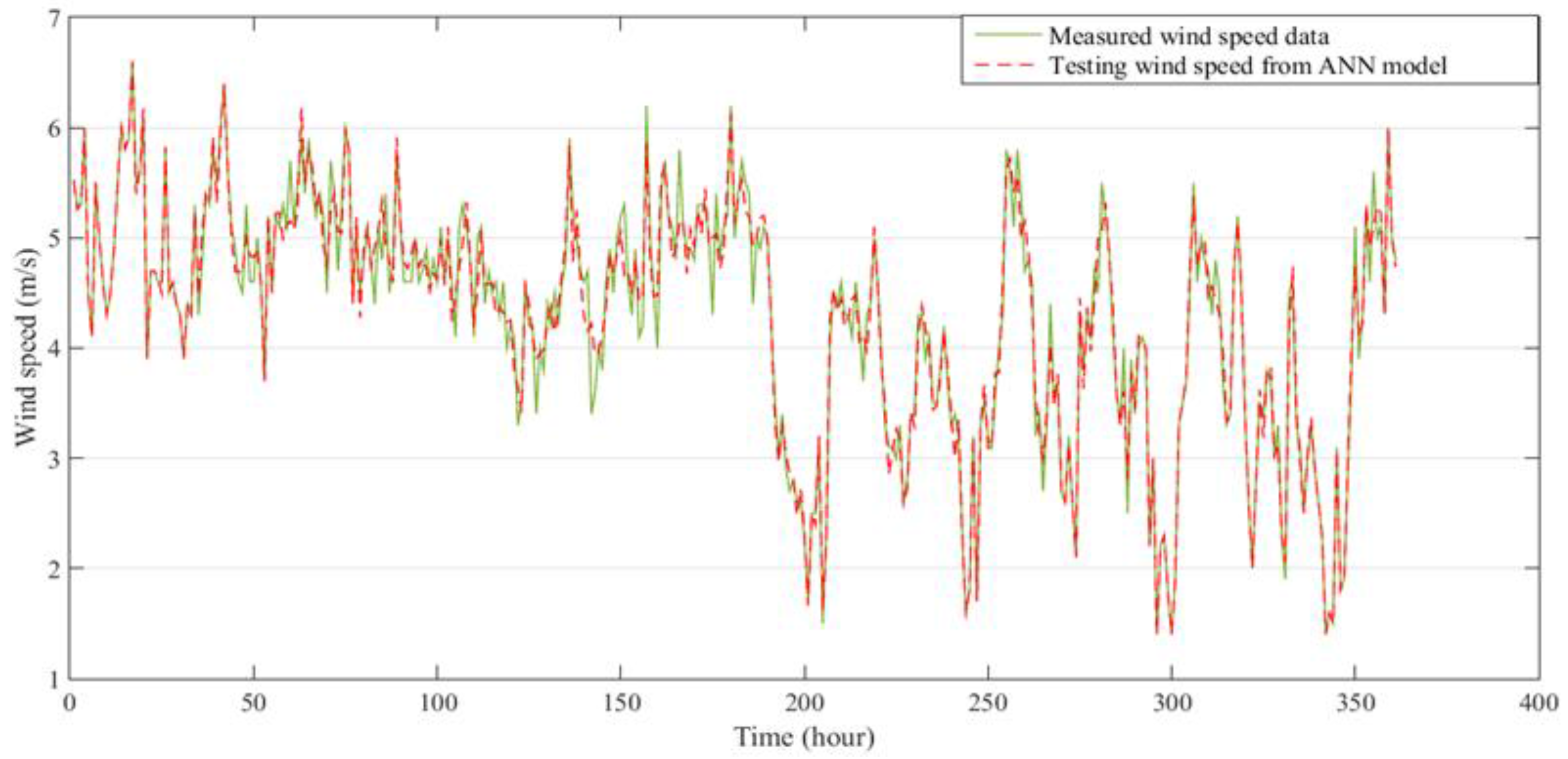

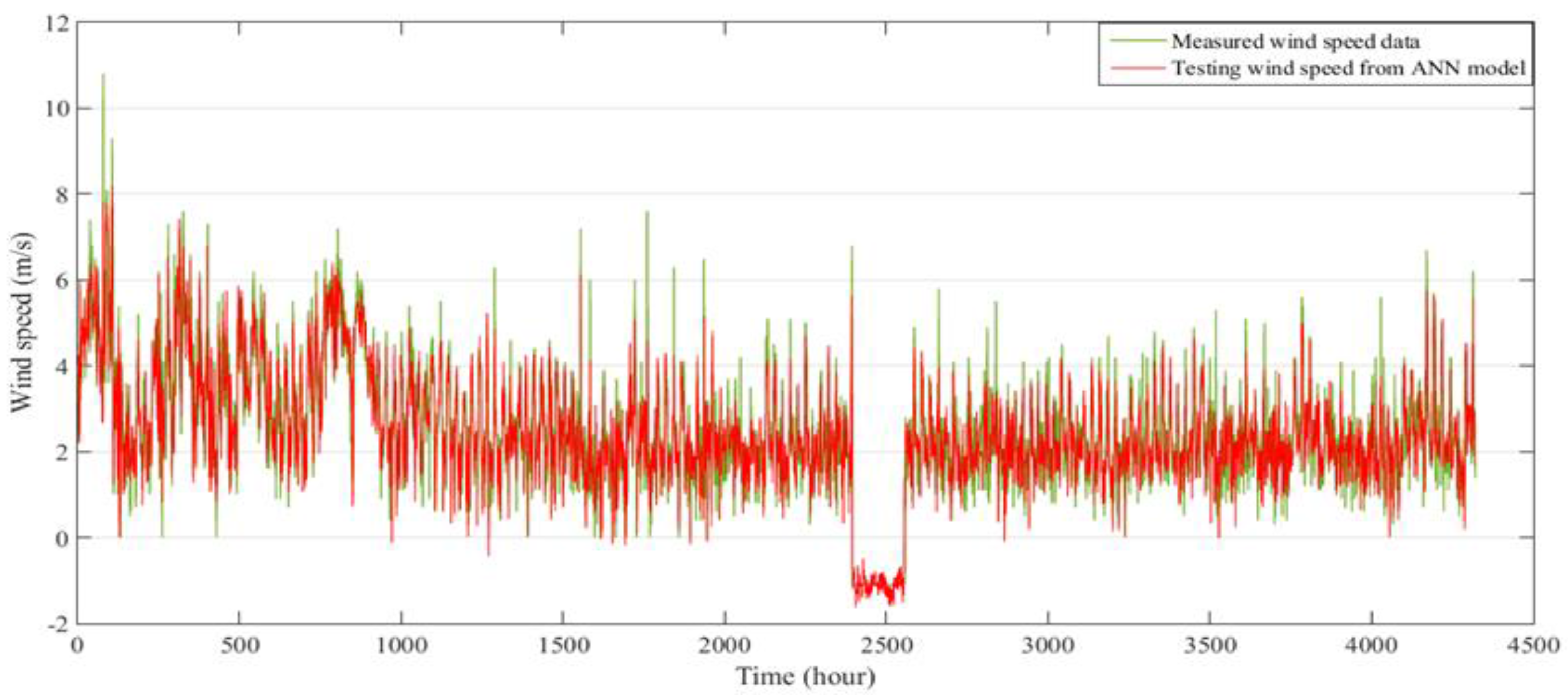
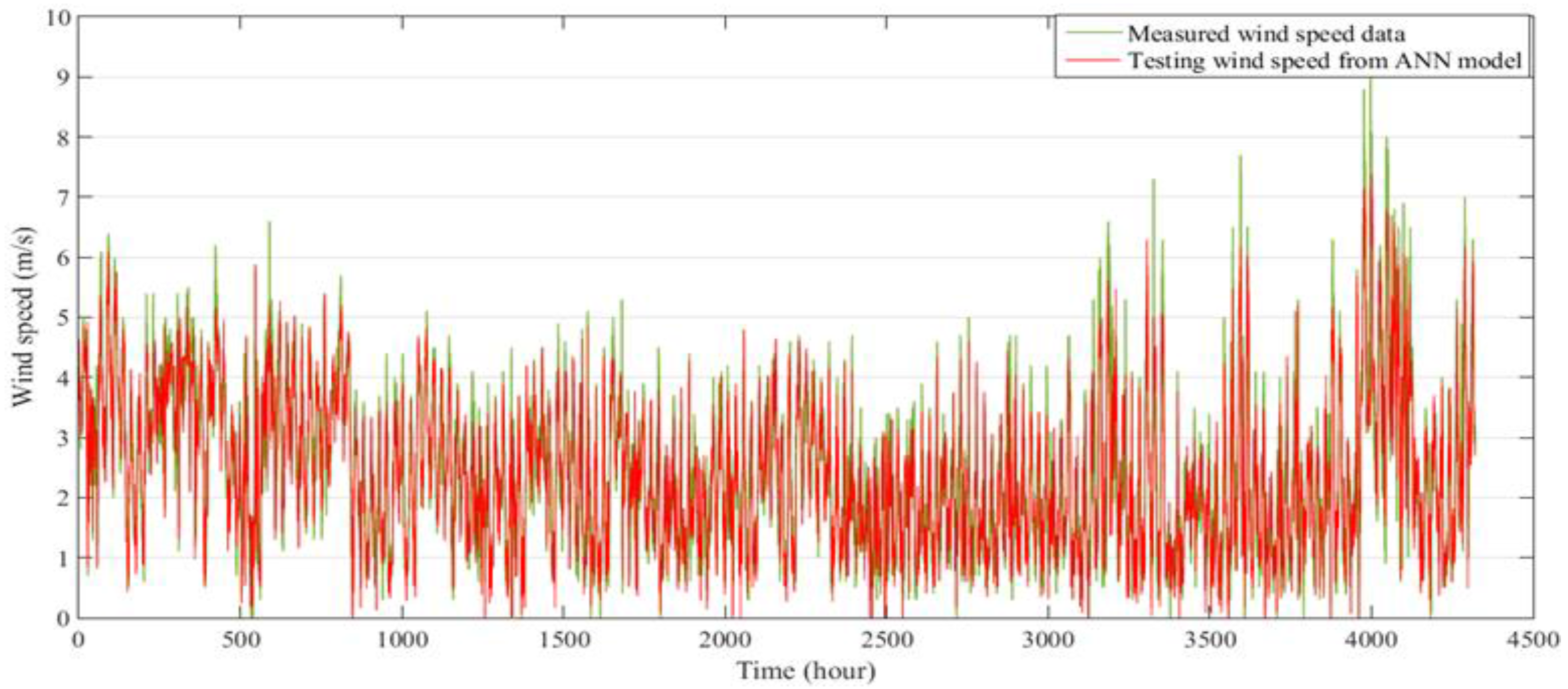

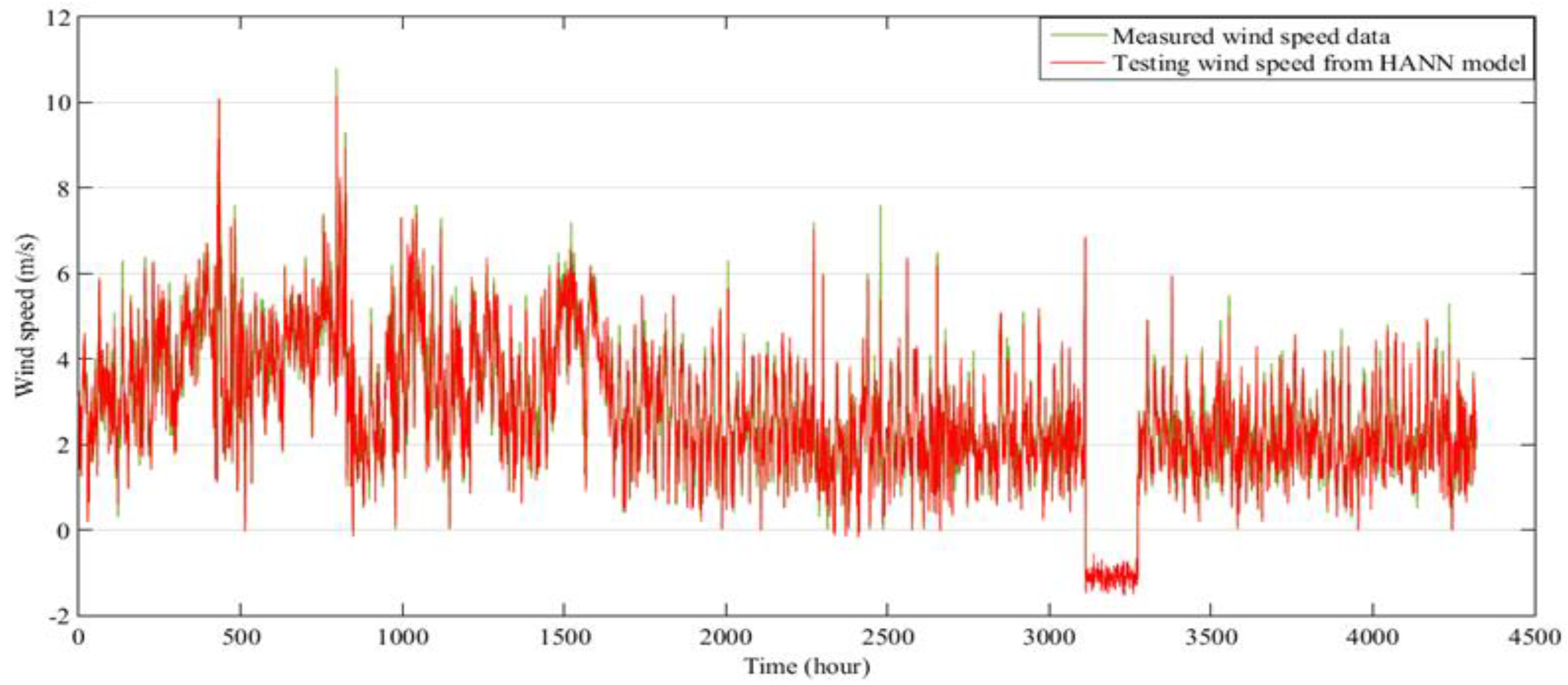
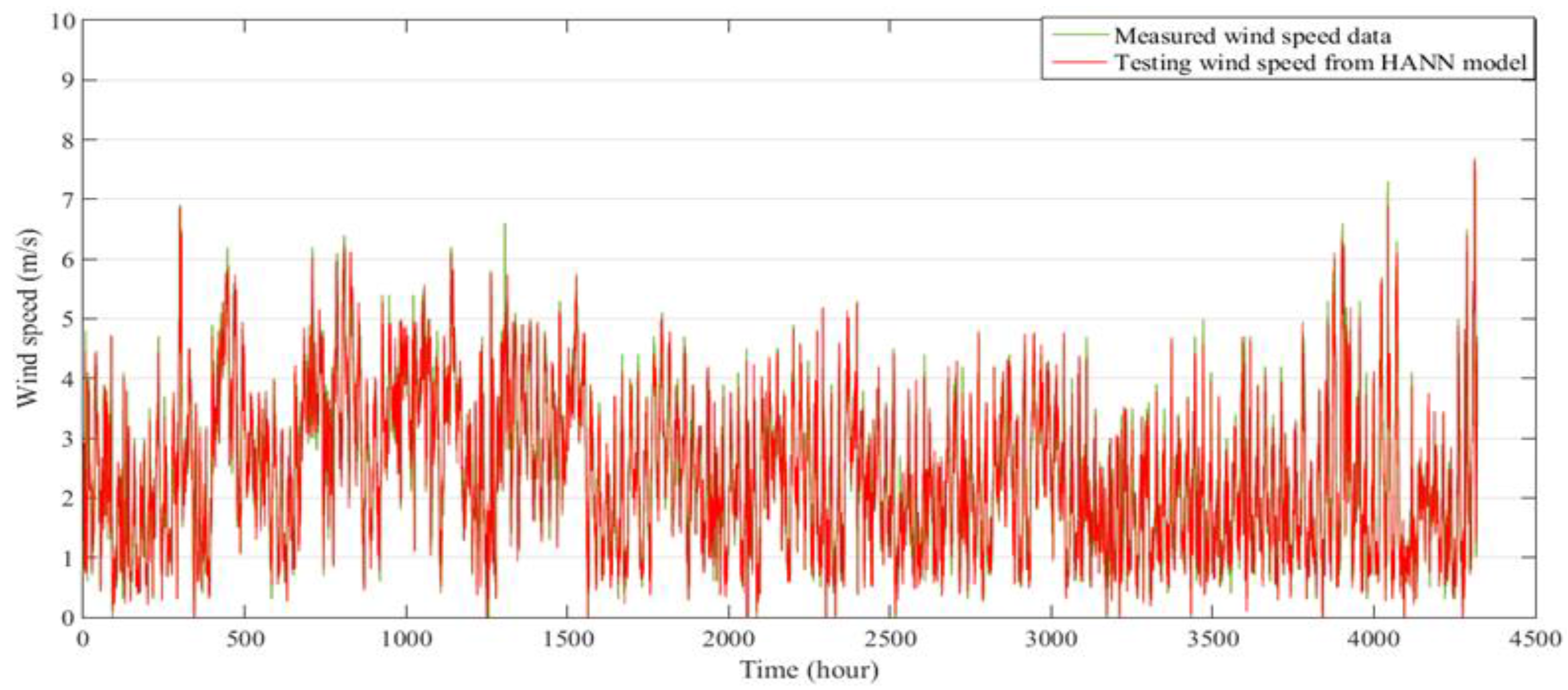

| Station | Latitude | Longitude | Altitude (m) |
|---|---|---|---|
| Mersing | 2°27′ N | 103°50′ E | 43.6 |
| Kuala Terengganu | 5°23′ N | 103°06′ E | 5.2 |
| Kudat | 6°55′ N | 116°50′ E | 3.5 |
| Month/Year 2015 | Mersing | Kudat | Kuala Terengganu | |||
|---|---|---|---|---|---|---|
| ⊽ | ⊽ | ⊽ | ||||
| January | 4.10 | 1.2809 | 3.08 | 1.2838 | 2.45 | 1.1840 |
| February | 4.13 | 1.4205 | 3.01 | 1.1849 | 2.21 | 1.1179 |
| March | 3.16 | 1.2627 | 3.13 | 1.1191 | 1.97 | 1.0388 |
| April | 2.59 | 0.9805 | 2.68 | 1.1232 | 1.80 | 0.8997 |
| May | 2.44 | 1.0748 | 2.09 | 1.3086 | 1.87 | 0.7819 |
| June | 2.74 | 1.2152 | 2.14 | 1.4235 | 1.71 | 0.8050 |
| July | 2.87 | 1.3338 | 2.54 | 1.6326 | 1.71 | 0.8031 |
| August | 3.02 | 1.4429 | 2.58 | 1.6159 | 1.81 | 0.8053 |
| September | 2.69 | 1.2636 | 2.04 | 1.3367 | 1.65 | 0.7898 |
| October | 2.64 | 1.1998 | 2.46 | 1.4856 | 1.63 | 0.8696 |
| November | 2.23 | 0.9127 | 2.11 | 1.1661 | 1.68 | 0.9186 |
| December | 3.31 | 1.5967 | 2.73 | 1.1498 | 2.42 | 1.3789 |
| Annual mean | 2.99 | 1.2487 | 2.55 | 1.3192 | 1.91 | 0.9494 |
| Month/Year 2015 | Mersing | Kudat | Kuala Terengganu | |||
|---|---|---|---|---|---|---|
| K | C | K | C | K | C | |
| January | 3.5527 | 4.5565 | 2.5979 | 3.4733 | 2.2034 | 2.7615 |
| February | 3.1998 | 4.6146 | 2.7640 | 3.3863 | 2.0979 | 2.4923 |
| March | 2.7192 | 3.5570 | 3.0682 | 3.5049 | 2.0084 | 2.2239 |
| April | 2.8760 | 2.9018 | 2.5796 | 3.0197 | 2.1309 | 2.0350 |
| May | 2.4439 | 2.7535 | 1.6682 | 2.3432 | 2.5826 | 2.1043 |
| June | 2.4242 | 3.0904 | 1.5626 | 2.3866 | 2.2781 | 1.9356 |
| July | 2.3027 | 3.2382 | 1.6193 | 2.8379 | 2.2806 | 1.9329 |
| August | 2.2365 | 3.4115 | 1.6677 | 2.8927 | 2.4141 | 2.0404 |
| September | 2.2803 | 3.0409 | 1.5864 | 2.2758 | 2.2342 | 1.8656 |
| October | 2.3599 | 2.9784 | 1.7338 | 2.7634 | 1.9767 | 1.8341 |
| November | 2.6516 | 2.5146 | 1.9072 | 2.3776 | 1.9279 | 1.8924 |
| December | 2.2129 | 3.7389 | 2.5681 | 3.0789 | 1.8415 | 2.7191 |
| Average | 2.60 | 3.37 | 2.11 | 2.86 | 2.16 | 2.15 |
| Mersing | ||||
|---|---|---|---|---|
| Model | Two-Week | Two-Month | ||
| MAPE | RMSE | MAPE | RMSE | |
| Weibull model | 0.880 | 1.650 | 1.575 | 2.429 |
| ANN model | 0.032 | 0.205 | 0.104 | 0.485 |
| HANN model | 0.014 | 0.081 | 0.065 | 0.259 |
| Model | Mersing | Kudat | Kuala Terengganu | |||
|---|---|---|---|---|---|---|
| MAPE | RMSE | MAPE | RMSE | MAPE | RMSE | |
| ANN model | 16.4% | 0.492 | 20.3% | 0.483 | 19.9% | 0.426 |
| HANN model | 6.06% | 0.048 | 8.06% | 0.039 | 8.01% | 0.034 |
© 2017 by the authors. Licensee MDPI, Basel, Switzerland. This article is an open access article distributed under the terms and conditions of the Creative Commons Attribution (CC BY) license (http://creativecommons.org/licenses/by/4.0/).
Share and Cite
Kadhem, A.A.; Wahab, N.I.A.; Aris, I.; Jasni, J.; Abdalla, A.N. Advanced Wind Speed Prediction Model Based on a Combination of Weibull Distribution and an Artificial Neural Network. Energies 2017, 10, 1744. https://doi.org/10.3390/en10111744
Kadhem AA, Wahab NIA, Aris I, Jasni J, Abdalla AN. Advanced Wind Speed Prediction Model Based on a Combination of Weibull Distribution and an Artificial Neural Network. Energies. 2017; 10(11):1744. https://doi.org/10.3390/en10111744
Chicago/Turabian StyleKadhem, Athraa Ali, Noor Izzri Abdul Wahab, Ishak Aris, Jasronita Jasni, and Ahmed N. Abdalla. 2017. "Advanced Wind Speed Prediction Model Based on a Combination of Weibull Distribution and an Artificial Neural Network" Energies 10, no. 11: 1744. https://doi.org/10.3390/en10111744






